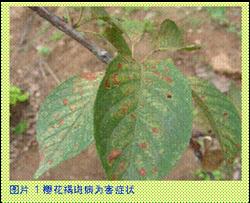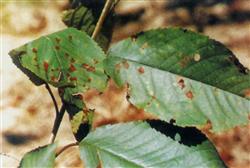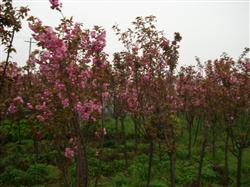How to prevent cherry brown spot disease?

How to prevent and cure cherry blossom brown spot? Please introduce in detail the cherry blossom brown spot disease, also known as cherry blossom brown spot perforation, which is an important disease in cherry blossom leaves. It has long been reported in Japan and other countries. The occurrence of cherry blossoms is common in Nanjing, Taiyuan, Tianjin, Shanghai, Chengdu, Xi'an, Suzhou, Jinan, Changsha, Lianyungang, Wuhan, Taiwan and other provinces and cities. The perforated leaves of infected cherry blossoms not only affect ornamental, but also defoliate ahead of time and affect their growth and development. The disease also affects cherry, plum blossom, peach and other stone fruit ornamental trees. Symptoms: Brown spot mainly harms the leaves of cherry blossoms and sometimes infects tender shoots. In the early stage of the disease, needle-sized spots appeared on the susceptible leaves, which were purple-brown and gradually expanded to form round or near-circular spots. The lesion is brown to grayish white, the edge of the spot is purple-brown, and the diameter can reach 5mm. In the later stage of the disease, grayish brown zero substances are produced on the disease spot, that is, the conidia and conidiophores of the pathogen. Finally, the central part of the lesion dried up and fell off, showing a perforated shape, with a neat edge of the perforation. When the disease is serious, the leaves are full of perforations, causing fallen leaves. Pathogen: the pathogen is CercosporacircumscissaSacc., which belongs to the subphylum Trichospora, Trichospora, Trichospora and Cercospora. The sexual type is MycosphaerellacerasellaAderh., which belongs to the subphylum ascomycetes, Coleoptera, Coleoptera and Streptomyces. But sexual type is rare in our country. Disease regularity: the pathogen overwintered with mycelium in the branch tip disease part of the susceptible plant, or overwintered with ascomycetes on the fallen leaves. In the spring of the following year, conidia were produced, and the spores spread by wind and rain and invaded the host from the stomata. The disease usually occurs first from the lower part of the crown and gradually extends to the upper part of the crown. In windy and rainy years, the disease is serious; the plant is too dense, the disease is easy to occur; the soil is barren, the disease is serious; the summer drought, the tree is weak, the disease is also serious. Japanese cherry blossoms and Japanese evening galls and other tree species have weak disease resistance and serious disease. Prevention and treatment: ① to reduce the source of infection: winter combined with pruning, removal of dead branches and fallen leaves, cutting off diseased branches, concentrated destruction. ② should strengthen the management, increase the application of organic fertilizer, phosphorus and potassium fertilizer, and irrigate in time, especially in the dry season, so as to improve plant disease resistance and control the occurrence of diseases. The right place for trees, avoid planting cherry blossoms in the tuyere. ③ medicament control: spray Bordeaux solution of 1 1RU 160 before sprouting, or stone sulphur mixture of Baume 2-3 degrees to prevent infection. During the onset period, 65% Dysen zinc wettable powder or 70% methyl topiramate wettable powder was sprayed with 500,800x or 1000 fold solution. Spray once every 10-15 days, 2-3 times. Click for more cherry blossom planting techniques click to get more flower planting techniques
- Prev

How to prevent and cure the perforation of cherry blossom brown spot?
How to prevent and cure the perforation of cherry blossom brown spot? Please introduce the method of cherry blossom brown spot perforation: first, the symptoms of perforation can be divided into fungi and bacteria. Cherry blossom brown spot perforation is caused by fungi, which is mainly harmful to leaves and also infects new shoots, starting from the lower part of the crown and gradually spreading upward. Get sick.
- Next

How to control cherry blossom diseases and insect pests?
How to control cherry blossom diseases and insect pests? Please guide the methods of prevention and control of cherry blossom diseases and insect pests for reference: 1, cherry blossom diseases and pests include mulberry white shield scale, all kinds of stinging moth, apple palm moth and so on. The mulberry white shield scale is mainly distributed in the cherry blossom cultivation area, and the occurrence is common, and it is quite serious in some fields. The damage has caused the basic shedding of leaves and the number of insect population.
Related
- Fuxing push coffee new agricultural production and marketing class: lack of small-scale processing plants
- Jujube rice field leisure farm deep ploughing Yilan for five years to create a space for organic food and play
- Nongyu Farm-A trial of organic papaya for brave women with advanced technology
- Four points for attention in the prevention and control of diseases and insect pests of edible fungi
- How to add nutrient solution to Edible Fungi
- Is there any good way to control edible fungus mites?
- Open Inoculation Technology of Edible Fungi
- Is there any clever way to use fertilizer for edible fungus in winter?
- What agents are used to kill the pathogens of edible fungi in the mushroom shed?
- Rapid drying of Edible Fungi

